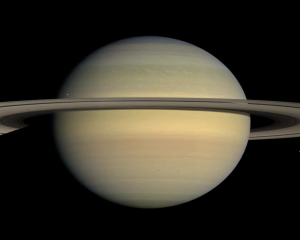In recent years, Saturn and Jupiter have been in a moon race of their own.
近年來,土星與木星展開了一場關于衛星數量的競賽。
In 2019, Saturn took the lead with 20 new natural satellites, bringing its tally up to 82. Then Jupiter surged ahead to 92 in 2023.
2019年,土星憑借新發現的20顆天然衛星,以總數82顆暫時領先。2023年,木星以92顆衛星實現反超。
And later that year, Saturn reached 146, leaving Jupiter in a respectable second place position with 95.
同年晚些時候,土星衛星總數達到146顆,木星則以95顆位居第二。
But this week, Jupiter has truly been left in the dust.
但本周,木星被遠遠甩在了后面。
Astronomers have just announced the detection of an additional 128 moons, brining Saturn's total to an eyewatering 274.
天文學家宣布新發現128顆土星衛星,這也使其衛星總數達到驚人的274顆。
"This is a stunning increase in the number of known moons orbiting Saturn, a number which is always hard to keep up with," says James O'Donoghue, a planetary astronomer at the University of Reading in England and who was not involved in the new discovery. "Jupiter is now very much in the rear-view mirror."
英國雷丁大學行星科學家詹姆斯·奧多諾休(未參與這一新發現)表示,“土星已知的衛星的數量出現了驚人地增長,這個數字讓人難以追趕。木星現在已經從后視鏡中遠去了。”
But having a seemingly insurmountable record number of moons isn't the most important part of the announcement.
但這項公告最重要的意義并非創造了看似難以超越的衛星數量紀錄。
That's because these 128 new satellites aren't regular Saturnian moons, spheres of ice and rock whose orbits are closely aligned with the planet's equator.
這是因為這128顆新衛星并非典型的土星衛星--也就是那些由冰和巖石構成、軌道與土星赤道面基本對齊的衛星。

Instead, these lumpy objects, each just a few miles across, are known as irregular moons, so named because they are "on these wild orbits," says Samantha Lawler, an astronomer at the University of Regina in Canada who wasn't directly involved in the new research.
加拿大里賈納大學天文學家薩曼莎·勞勒(未直接參與該研究)指出,這些直徑只有幾英里的塊狀天體被稱為“不規則衛星”,是因其“擁有狂野的運行軌道”。
They swing around the gas giant at steep angles, often in the opposite direction to Saturn's own rotation.
這些衛星以陡角環繞這顆氣態巨行星運行,通常與土星自轉方向相反。
These clues point toward a protracted destruction derby.
這些線索指向了一場曠日持久的破壞對決。
Several billion years ago, larger voyagers made of rock and ice were captured by Saturn's gravity, becoming moons in the process.
數十億年前,由冰和巖石構成的大型天體被土星引力捕獲,在此過程中成為了衛星。
Eventually, some of them smashed into one another, triggering a cascade of moon-on-moon violence that created hundreds of tinier, younger moons -- each a fragment of their obliterated ancestors -- that was still taking place as recently as 100 million years ago.
最終,其中一些相互碰撞,引發了一連串的衛星撞擊事件,產生了數百顆更小、更年輕的衛星--每顆都是被摧毀的“前輩”的碎片,這種撞擊事件最近一次就發生在1億年前。
That makes finding 128 moons more than just cosmic bean counting.
這使得發現128顆新衛星絕非簡單的宇宙數字游戲。
They are adding rich new detail to the chaotic history of the Saturnian system, a work-in-progress where nothing -- from its moons to its resplendent rings -- are permanent fixtures, but rather temporary decorations.
它們為土星系統的混沌歷史增添了豐富的新細節,揭示了這個仍在演變中的天體系統--從衛星到璀璨光環,沒有什么是永恒的存在,一切都只是暫時的裝飾。












